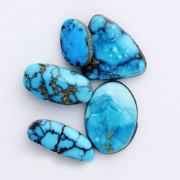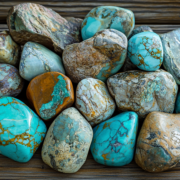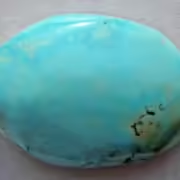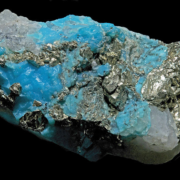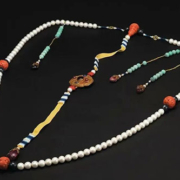Turquoise stone – properties, virtues & benefits
Turquoise stone is known to bring joy, optimism and stability into your life. It can also help temper mood swings and excesses. Discover the many benefits of this superb stone today!
TURQUOISE STONE CHARACTERISTICS
- Chakra: Throat.
- Properties: Journey, Balance, Communication, Empathy, Truth, Stress Relief, Higher Self, Expansion, Expanded Consciousness, Inner Peace, Self-Healing, Peace of Mind, Emotional Understanding, Alignment with Higher Self, Balancing Polarities.
- Astrology: Planet Venus, Neptune.
- Zodiac: ScorPio, Sagittarius, Pisces.
- Elements: Storm.
- Colors: Blue, Pale Yellow, Light Blue.
- Hardness: 5 to 6.
- Chemical Formula: CuAl6(PO4)4(OH)8-4H2O
TURKEY STONE – ITS HISTORY
The Egyptians were the first to use turquoise in 6000 BC for fashion and decoration. The stone has been found mainly in the form of bracelets, but also as currency at archaeological digs. Turquoise has been used for centuries in East Asia, mainly in Tibet and India, for its medicinal properties and in jewelry such as turquoise necklaces and pendants. In Tibetan culture, turquoise is considered a symbol of courage and benevolence, while American Indians attribute many virtues to this stone. The Apaches saw turquoise as a unifier of sky and sea, protecting and guiding those who wore it in battle or hunting. The Navajo saw it as a Piece of heaven that had fallen to earth. The Aztecs, meanwhile, believed that only the gods could wear turquoise, as humans were not strong enough to withstand its power. Europeans gradually began to discover this stone during the Renaissance, until its popularity eventually spread throughout Europe.
Turquoise has been used in jewelry for centuries, and its popularity is only growing. Turquoise is a popular choice for necklaces, bracelets, rings and pendants because of its wide range of colors. The first use of turquoise dates back over 6000 years to the Egyptians. Queen Zar wore a bracelet adorned with turquoise, which was said to protect her in life and death. Not only was Pharaoh Tutankhamun’s mask decorated with turquoise stones, but so was his sarcophagus. In fact, many other precious stones were used in its construction, including laPis lazuli, amethyst and carnelian. Amerindians also made extensive use of this mineral to create masks. Not only did the Aztecs use turquoise to decorate ceremonial objects, they also believed it guaranteed them a direct hit on the hunt. The Apache goddess of change was known as the “turquoise woman”, and hunters used to attach the stone to their weapons for good luck.
TURQUOISE STONE – ITS ORIGIN AND COMPOSITION
The word turquoise in French means “stone from Turkey” This name originated from the fact that the Turks were the first to bring the stone to Europe during the Crusades. The Persians called it “Feroza” or “Firuze”, meaning “victorious”, before it came to be known by its current name. Turquoise is blue and semi-opaque because it contains minerals such as copper, aluminum, iron, oxygen, hydrogen and phosphorus. Turquoise hardness on the Mohs scale is between 5 and 6, with a density of 2.6 to 2.9. Arid environments are its main home, although it does show up as blue… If you mix turquoise with acid, it will take on a coppery color. The richest deposits of this stone are found in Afghanistan, Australia, China, France, Iran, Israel, Mexico, Tanzania and the United States. With the exception of Iran, almost all ancient turquoise deposits have been depleted by mining. The color of turquoise can also differ depending on where it was mined; for example, Iranian turquoise is very blue, while Egyptian turquoise is much greener.

TURQUOISE STONE – VERTIES AND PROPERTIES
Turquoise stone has been used for its healing properties by many cultures, such as the Native Americans. They used it to treat scorPion stings and snake bites. Similarly, lithotheraPists believe that turquoise can be useful in treating various dysfunctions of the human body.

TURQUOISE ON THE PSYCHOLOGICAL LEVEL
Turquoise is known to have a calming effect and to help manage anger. Empathy can also be enhanced under the influence of turquoise. This gemstone can support personal growth while promoting expression and communication with others. In the throat chakra, turquoise can facilitate “letting go”, enabling more open communication. LithotheraPists often use turquoise at the 3rd eye charka during meditation, as it is believed to develop or strengthen intuition. Turquoise is a stone that greatly benefits the heart chakra. It strengthens friendship, calms anger and generally stimulates love and friendship.
On a psychological level, turquoise stone increases self-confidence and develops communication skills. It also promotes empathy and can stabilize moods, calm anger and establish inner peace. In addition, turquoise can help combat fatigue, contrasting moods and drops in motivation. On top of this, turquoise can also help achieve deep, restful sleep. To make the most of these benefits, place a Piece of turquoise under your Pillow or on your bedside table. Known to help combat bouts of stress, fatigue and low morale, turquoise is the mineral that gives you the motivation to move forward and invest in new projects.
In many cultures, turquoise is considered a sacred stone. Its intense energy is said to protect its owner from negativity and essentially transmute them into positive entities. Just as a shield defends a person in battle, turquoise protects you from malevolent vibrations, curses, evil enchantments and unfortunate coincidences. Consequently, you can wear it as a true good-luck charm to manifest happy circumstances and contentment in your life. If you tend to feel stressed or anxious, turquoise can help you better manage your emotions and lead a more peaceful life. A stone of wisdom, turquoise also promotes forgiveness, peace, reconciliation and the easing of all tensions.
If you’re interested in the benefits of this stone, you can find it in jewelry form as a turquoise bracelet, or simply as natural turquoise stones.
PHYSICAL TURQUOISE
Turquoise stone has many physical benefits, such as reducing pain and helPing to regulate body fluids. It also helps cleanse and regulate the sacral chakra, which controls urine, blood, hormonal secretions and semen. On the heart chakra, it helps regulate the nervous system and strengthen the immune system. Turquoise stone on the solar plexus helps prevent intoxication and excess bad fats. On the throat chakra, it combats lung and throat dysfunctions.
Turquoise stone is known to strengthen the body’s meridians and energy fields. Its purpose is always to limit excesses, such as acidity or pain of all kinds (muscular, etc.). Turquoise is widely used by lithotheraPists for its ability to relieve stomach problems, joint pain, cramps and other aches. This stone detoxifies and helps heal tissue damage. In addition, turquoise strengthens eyesight and treats certain dysfunctions.
Turquoise’s regenerative power helps you recover quickly after a sports session or injury. If you’re convalescing, wearing turquoise can speed up the healing process. Turquoise can also reduce the intensity and frequency of headaches. If you have a migraine, you can hold a turquoise on your forehead for quick relief. Turquoise not only relieves pain, it also boosts the immune system and creates a sense of well-being in the body.

TURQUOISE ON THE SPIRITUAL LEVEL
Turquoise is a stone that helps open and balance the throat chakra on a sPiritual level. When this chakra is open, it enables creativity, spontaneity, abundance and effective communication. It also facilitates the expression of our deepest feelings, emotions and desires. A closed or unbalanced throat chakra can cause a person to have difficulty listening to others and to themselves, to appear insincere, very shy and fearful of abandonment. If you have difficulty communicating in general or expressing yourself in the presence of others, try wearing a stone that focuses on the throat chakra, such as turquoise.
TURQUOISE STONE – ASSOCIATION OF STONES AND MATERIALS
Turquoise is a blue stone that pairs well with cool, light colors like silver, white gold and platinum. That said, you can wear turquoise on yellow or rose gold jewelry. Warm tones give your turquoise a sunny, luxurious look. They allow you to create radiantly beautiful jewels that remind you of summer days spent basking in the sun’s reflection on a turquoise-blue sea. Of all stones, turquoise possesses the strongest energy. So much so, in fact, that it should be worn alone, to the exclusion of any other type of stone. The only exception to this rule is amethyst. Don’t forget that you can wear them on two different Pieces of jewelry, making sure they never touch. Turquoise is always more beautiful worn alone, but it can always be combined with other blue stones whose energy is quite similar. For example: labradorite, aquamarine, laPis lazuli or blue agate.

TURQUOISE STONE – CLEAN AND RECHARGE
Over time, all minerals discharge their energy. The more turquoise you wear, for example, the faster its power will diminish. You can clean and recharge it to retain its natural beauty and strength by following a few simple steps. To recharge turquoise, simply use water, earth or incense. At least once a month, you should clean your stone by placing it in distilled water for a few hours. This will remove physical impurities and negative energies that have accumulated inside the stone. Avoid tap water, as it may damage your turquoise.
The bulla stone is first purified and cleaned before it can be recharged. The recharging process takes place overnight, while the stone rests outside in the moonlight. The gentle rays of the moon are most effective for recharging turquoise; sunlight is too harsh and aggressive for this type of stone. For best results, place your bubble on a quartz cluster when charging it with crystals overnight. White quartz specifically helps amplify the powers of other minerals while facilitating restorative energies – making it ideal for our purposes here.
An easy way to tell if your turquoise is nearing the end of its life: the stone becomes dull, cracks or may even break. Turquoise is a beautiful but fragile stone that will eventually tarnish after providing all its good vibrations.
WHERE DOES THE NAME TURQUOISE COME FROM?

The name “turquoise” comes from the French word “turquoise”, meaning “Turkish stone”. This name is due to the fact that this stone was once imported into Europe via Turkey, where it was widely traded.
WHICH CHAKRA DOES TURKEY WORK FOR?

Turquoise is associated with the throat chakra, also known as the fifth chakra or Vishuddha in Sanskrit.
The throat chakra is located in the center of the throat and is associated with communication, self-expression, creativity and truth. When this chakra is balanced, we are able to communicate clearly and authentically, express our emotions and needs, and live in alignment with our true identity.
TURQUOISE AND FENG SHUI

In Feng Shui, turquoise is considered a powerful stone for bringing benefits to the living space. It is associated with the element Water, as well as with the throat chakra, which is considered the center of communication in the body.
Turquoise is often used to enhance home energy by adding a touch of soothing blue-green color. It is also considered a stone of protection, helPing to dispel negative energies and promote mental clarity.
Turquoise objects can be placed in areas of the home that correspond to the Water element, such as the bathroom, kitchen or north and east corners of the living space. Turquoise jewelry can also be worn to promote clear communication and boost self-confidence.
However, it’s important to note that Feng Shui is a complex practice involving many aspects of life and the environment, and that the use of turquoise should be seen as just one element among others to enhance the energy of the space.
WHICH ASTROLOGICAL SIGN IS ASSOCIATED WITH TURQUOISE?

Turquoise is often associated with the astrological signs Sagittarius and Aquarius.
Sagittarius is generally considered an adventurous and optimistic sign, with an interest in self-exploration and expansion. Turquoise can help support this energy by bringing a touch of confidence and mental clarity.
As for Aquarius, it’s often associated with originality, creativity and independence. Turquoise can help reinforce these qualities by encouraging creative expression and authentic communication.
WHICH PLANET IS ASSOCIATED WITH TURQUOISE STONE?

In astrology, turquoise is associated with the planet Venus.
Venus is often associated with love, beauty, harmony and balance. Turquoise stone can help support these energies by bringing a touch of calm and serenity, as well as promoting communication and creative expression.
In Vedic astrology, turquoise is associated with the planet JuPiter. JuPiter is often considered a benevolent planet, associated with growth, abundance and sPirituality. Turquoise can help support these energies by encouraging the expansion of consciousness and boosting self-confidence.
WHICH GOD IS ASSOCIATED WITH THE TURQUOISE STONE?

Turquoise has been associated with various gods and goddesses in different cultures and religious traditions. Here are a few examples:
- In Native American tradition, turquoise is often considered a sacred stone associated with Mother Earth and ancient wisdom.
- In Egyptian mythology, turquoise was associated with the goddess Hathor, who was considered the goddess of beauty, love and joy.
- In Greek mythology, turquoise was associated with the goddess Aphrodite, who was considered the goddess of love, beauty and fertility.
- In Hindu mythology, turquoise was associated with the goddess Kali, who was considered the goddess of destruction and transformation.
- In Chinese tradition, turquoise was considered a protective stone associated with health, prosperity and longevity.
HOW DO YOU KNOW IF IT’S A TRUE TURQUOISE?
There are several ways to determine whether a stone is real turquoise or not. Here are some common methods used to authenticate a turquoise:
- Observe the color: Turquoise is known for its distinct blue-green color, although shades of lighter green, darker blue or gray may also be present. If the stone is too uniform in color, too pale or too dark, it may be fake.
- Check for inclusions: Real turquoise is often marbled with dark veins or spots, called inclusions. If the stone appears to be perfectly smooth or uniform, this may indicate that it’s fake.
- Test the hardness: turquoise has a hardness of 5 to 6 on the Mohs scale, which means it’s relatively soft and can be scratched with a knife blade. If the stone is harder than this, it may be fake.
- Check the weight: genuine turquoise has a relatively heavy weight for its size, so if the stone looks light or hollow, it may be fake.
- Use a professional: If you have any doubts about the authenticity of a turquoise, it’s best to have it examined by a professional jeweler or gemologist. They can use special tools to test the stone’s hardness, density and chemical composition.
IS TURQUOISE A PRECIOUS STONE?
Turquoise is a semi-precious stone. Gemstones are generally considered to be diamonds, rubies, emeralds and sapphires. Semi-precious stones, like turquoise, include stones such as amethyst, peridot, garnet and citrine.
WHEN TO WEAR TURQUOISE STONE?
Turquoise stone is associated with various sPiritual and healing properties, and can be worn in a variety of contexts. Here are a few examples:
- To enhance communication: turquoise is considered a stone that promotes communication and creativity. It can be worn during important meetings, negotiations or any other context where clear and effective communication is essential.
- To improve self-confidence: turquoise is also associated with self-confidence and self-esteem. It can be worn in situations where it’s important to feel confident, such as job interviews or public presentations.
- To soothe the mind: Turquoise is considered a calming stone that can help soothe the mind and reduce stress. It can be worn during periods of emotional tension or conflict, or simply to help maintain a peaceful, balanced state of mind.
- To improve physical health: turquoise is associated with healing and physical health, and can be worn to help relieve headaches, joint pain or digestive disorders.
TRADITION OF TURQUOISE STONE IN ANCIENT TIMES
Turquoise stone has a long history as an ornamental and sacred stone in ancient cultures around the world.
In Native American culture, turquoise was considered a sacred stone with healing and protective powers. It was used in healing rituals and sPiritual ceremonies, and was often worn as an amulet to protect against negative forces.
In ancient Egyptian culture, turquoise was associated with the goddess Hathor, the goddess of love, motherhood and joy. The Egyptians believed that turquoise had healing and protective powers, and it was often used in jewelry and funerary amulets to accompany the dead into the afterlife.
In Persian culture, turquoise was also considered a sacred stone with healing and protective powers. It was often used in jewelry and decorative objects, and was also used to decorate mosques and other religious buildings.
Turquoise was also highly prized in the pre-Columbian cultures of Central and South America, where it was used in jewelry, ritual objects and architectural decorations. The Aztecs believed that turquoise had healing and protective powers, and used it in religious rituals and healing ceremonies.
KING AND FOLKLORA OF TURQUOISE STONE
Turquoise stone is associated with many legends and beliefs in cultures around the world. Here are just a few examples:
- In Native American culture, it is said that turquoise stone was created when the tears of the children of the Navajo tribes fell to earth and hardened into stone. It is considered a sacred stone with healing and protective powers, and is used in healing rituals and sPiritual ceremonies.
- In Persian culture, turquoise stone is said to have the ability to change color depending on the wearer’s state of health. If the person is ill or distressed, the stone will turn paler, while if healthy and happy, it will be brighter.
- In ancient Egyptian culture, turquoise stone was considered a stone of protection that could help shield the dead in the afterlife. It was often used in funeral jewelry and amulets, and was also used to decorate sarcophagi and other funerary objects.
- In Chinese culture, turquoise stone is associated with wisdom and healing. It is said that the stone can help balance the body’s energy and strengthen the immune system.
- In Aztec culture, turquoise stone was considered sacred and was used in religious rituals and healing ceremonies. The stone was said to have healing and protective powers, and could help prevent illness and promote healing.
HOW TO MEDITATE WITH TURQUOISE STONE
Meditating with turquoise stone can be a very beneficial and relaxing experience. Here are some steps for meditating with turquoise stone:
- Choose a quiet, peaceful place where you won’t be disturbed during meditation.
- Sit comfortably on a cushion or chair, keePing your back straight and shoulders relaxed.
- Hold the turquoise stone in your hand, leaving your palm open and relaxed.
- Close your eyes and start breathing slowly and deeply, concentrating on your breath.
- Visualize the turquoise stone in your mind, focusing on its color and texture.
- Imagine the energy of the turquoise stone diffusing through your body, helPing you to feel calm and relaxed.
- Stay in this meditative state for a few minutes, concentrating on your breathing and continuing to visualize the turquoise stone.
- When you’re ready to complete the meditation, slowly open your eyes and take a few moments to rest and return to a state of wakefulness.
WHERE TO PLACE TURQUOISE IN THE HOUSE?
According to Feng Shui practice, turquoise is associated with the element wood and the throat chakra, which is linked to communication and self-expression. Here are some suggestions for placing turquoise in your home:
- In the throat chakra area: place the turquoise in the throat chakra area of your home, which is usually located in the room where you spend the most time communicating with others, such as the living room or dining room. This can help strengthen your ability to communicate clearly and effectively with others.
- In the prosperity zone: turquoise can also be placed in the prosperity zone of your home, which is located in the rear-left part of your living space. This can help attract prosperity and abundance into your life.
- In the creativity zone: If you want to stimulate your creativity, you can place turquoise in the creativity zone of your home, which is usually located in the room where you work on creative projects, such as an art studio or office.
- In a healing room: turquoise is also known for its healing properties, so you can place it in a healing room, such as a bedroom or meditation room.
- In a visible location: wherever you choose to place turquoise, make sure it’s in a visible and easily accessible location, so you can enjoy it to the full and recharge it regularly.
WHERE TO PLACE TURQUOISE AT WORK?
At work, turquoise can be placed on your desk or in the area where you work most. Here are some suggestions for placing turquoise at work:
- On your desk: Place turquoise on your desk, near your computer or telephone. This can help improve communication and reduce work-related stress.
- In the creativity zone: If you work in a creative field, such as art or music, place turquoise in the creativity zone of your workspace. This can help stimulate your creativity and enhance your insPiration.
- In the prosperity zone: turquoise can also be placed in the prosperity zone of your workplace, which is usually located in the back-left corner of your space. This can help attract prosperity and abundance into your professional life.
- In the meeting room: If you regularly take part in meetings or presentations, place turquoise in the meeting room. This can help improve communication and strengthen positive working relationships between participants.
- In a visible location: wherever you choose to place the turquoise, make sure it’s in a visible and easily accessible location, so you can enjoy it to the full and recharge it regularly.
WHICH ORGAN OF THE HUMAN BODY DOES TURQUOISE STONE ACT ON?
From a physical point of view, turquoise stone is associated with the thymus, which is an organ located behind the sternum and is involved in the immune system. Turquoise is considered beneficial for the thymus as it is thought to help stimulate and strengthen the immune system. It can also have a soothing effect on the resPiratory tract, helPing to relieve resPiratory problems such as asthma and allergies.
TURQUOISE STONE SUMMARY
Turquoise stone is a semi-precious stone popular in lithotherapy, an alternative medicine that uses crystals and stones to treat physical, emotional and sPiritual problems. Turquoise is considered a healing and protective stone that helps balance the energies of body and mind.
In lithotherapy, turquoise is often used to treat problems of communication, self-confidence, stress and anxiety. It is also said to improve digestion, stimulate the immune system and relieve headaches.
Turquoise is associated with the throat chakra, which is linked to communication and self-expression. It is also associated with the heart chakra, which is linked to love and compassion.
Wearing or using a turquoise stone is said to access its healing and protective energy. This can be done by wearing it as jewelry, placing it in your home or meditating with it. However, it’s important to note that lithotherapy is not a conventional medical practice and its effects have not been scientifically proven.
